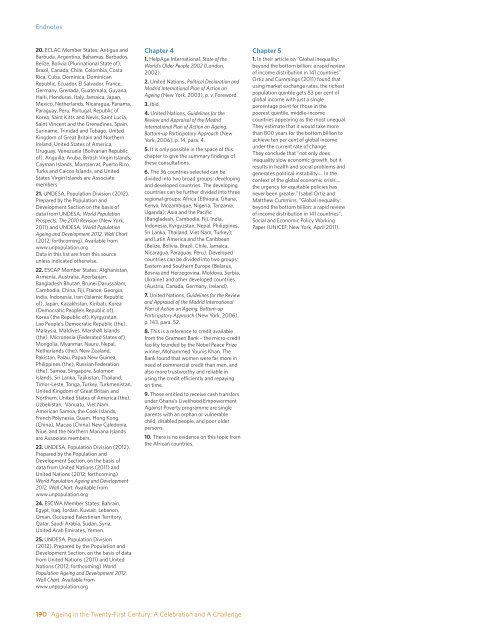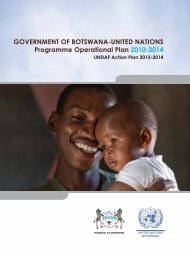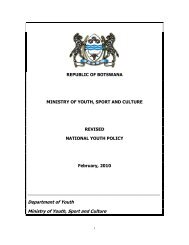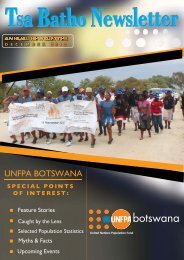Ageing in the Twenty-First Century: - HelpAge International
Ageing in the Twenty-First Century: - HelpAge International
Ageing in the Twenty-First Century: - HelpAge International
Create successful ePaper yourself
Turn your PDF publications into a flip-book with our unique Google optimized e-Paper software.
Endnotes<br />
20. ECLAC Member States: Antigua and<br />
Barbuda, Argent<strong>in</strong>a, Bahamas, Barbados,<br />
Belize, Bolivia (Plur<strong>in</strong>ational State of),<br />
Brazil, Canada, Chile, Colombia, Costa<br />
Rica, Cuba, Dom<strong>in</strong>ica, Dom<strong>in</strong>ican<br />
Republic, Ecuador, El Salvador, France,<br />
Germany, Grenada, Guatemala, Guyana,<br />
Haiti, Honduras, Italy, Jamaica, Japan,<br />
Mexico, Ne<strong>the</strong>rlands, Nicaragua, Panama,<br />
Paraguay, Peru, Portugal, Republic of<br />
Korea, Sa<strong>in</strong>t Kitts and Nevis, Sa<strong>in</strong>t Lucia,<br />
Sa<strong>in</strong>t V<strong>in</strong>cent and <strong>the</strong> Grenad<strong>in</strong>es, Spa<strong>in</strong>,<br />
Sur<strong>in</strong>ame, Tr<strong>in</strong>idad and Tobago, United<br />
K<strong>in</strong>gdom of Great Brita<strong>in</strong> and Nor<strong>the</strong>rn<br />
Ireland, United States of America,<br />
Uruguay, Venezuela (Bolivarian Republic<br />
of). Anguilla, Aruba, British Virg<strong>in</strong> Islands,<br />
Cayman Islands, Montserrat, Puerto Rico,<br />
Turks and Caicos Islands, and United<br />
States Virg<strong>in</strong> Islands are Associate<br />
members.<br />
21. UNDESA, Population Division (2012).<br />
Prepared by <strong>the</strong> Population and<br />
Development Section on <strong>the</strong> basis of<br />
data from UNDESA, World Population<br />
Prospects: The 2010 Revision (New York,<br />
2011) and UNDESA, World Population<br />
<strong>Age<strong>in</strong>g</strong> and Development 2012, Wall Chart<br />
(2012; forthcom<strong>in</strong>g). Available from<br />
www.unpopulation.org<br />
Data <strong>in</strong> this list are from this source<br />
unless <strong>in</strong>dicated o<strong>the</strong>rwise.<br />
22. ESCAP Member States: Afghanistan,<br />
Armenia, Australia, Azerbaijan,<br />
Bangladesh Bhutan, Brunei Darussalam,<br />
Cambodia, Ch<strong>in</strong>a, Fiji, France, Georgia,<br />
India, Indonesia, Iran (Islamic Republic<br />
of), Japan, Kazakhstan, Kiribati, Korea<br />
(Democratic People’s Republic of),<br />
Korea (<strong>the</strong> Republic of), Kyrgyzstan,<br />
Lao People’s Democratic Republic (<strong>the</strong>),<br />
Malaysia, Maldives, Marshall Islands<br />
(<strong>the</strong>), Micronesia (Federated States of),<br />
Mongolia, Myanmar, Nauru, Nepal,<br />
Ne<strong>the</strong>rlands (<strong>the</strong>), New Zealand,<br />
Pakistan, Palau, Papua New Gu<strong>in</strong>ea,<br />
Philipp<strong>in</strong>es (<strong>the</strong>), Russian Federation<br />
(<strong>the</strong>), Samoa, S<strong>in</strong>gapore, Solomon<br />
Islands, Sri Lanka, Tajikistan, Thailand,<br />
Timor-Leste, Tonga, Turkey, Turkmenistan,<br />
United K<strong>in</strong>gdom of Great Brita<strong>in</strong> and<br />
Nor<strong>the</strong>rn, United States of America (<strong>the</strong>),<br />
Uzbekistan, Vanuatu, Viet Nam.<br />
American Samoa, <strong>the</strong> Cook Islands,<br />
French Polynesia, Guam, Hong Kong<br />
(Ch<strong>in</strong>a), Macao (Ch<strong>in</strong>a) New Caledonia,<br />
Niue, and <strong>the</strong> Nor<strong>the</strong>rn Mariana Islands<br />
are Associate members.<br />
23. UNDESA, Population Division (2012).<br />
Prepared by <strong>the</strong> Population and<br />
Development Section, on <strong>the</strong> basis of<br />
data from United Nations (2011) and<br />
United Nations (2012; forthcom<strong>in</strong>g)<br />
World Population <strong>Age<strong>in</strong>g</strong> and Development<br />
2012, Wall Chart. Available from<br />
www.unpopulation.org<br />
24. ESCWA Member States: Bahra<strong>in</strong>,<br />
Egypt, Iraq, Jordan, Kuwait, Lebanon,<br />
Oman, Occupied Palest<strong>in</strong>ian Territory,<br />
Qatar, Saudi Arabia, Sudan, Syria,<br />
United Arab Emirates, Yemen.<br />
25. UNDESA, Population Division<br />
(2012). Prepared by <strong>the</strong> Population and<br />
Development Section, on <strong>the</strong> basis of data<br />
from United Nations (2011) and United<br />
Nations (2012; forthcom<strong>in</strong>g) World<br />
Population <strong>Age<strong>in</strong>g</strong> and Development 2012,<br />
Wall Chart. Available from<br />
www.unpopulation.org<br />
Chapter 4<br />
1. <strong>HelpAge</strong> <strong>International</strong>, State of <strong>the</strong><br />
World’s Older People 2002 (London,<br />
2002).<br />
2. United Nations, Political Declaration and<br />
Madrid <strong>International</strong> Plan of Action on<br />
<strong>Age<strong>in</strong>g</strong> (New York, 2003), p. v, Foreword.<br />
3. Ibid.<br />
4. United Nations, Guidel<strong>in</strong>es for <strong>the</strong><br />
Review and Appraisal of <strong>the</strong> Madrid<br />
<strong>International</strong> Plan of Action on <strong>Age<strong>in</strong>g</strong>,<br />
Bottom-up Participatory Approach (New<br />
York, 2006), p. 14, para. 4.<br />
5. It is only possible <strong>in</strong> <strong>the</strong> space of this<br />
chapter to give <strong>the</strong> summary f<strong>in</strong>d<strong>in</strong>gs of<br />
<strong>the</strong>se consultations.<br />
6. The 36 countries selected can be<br />
divided <strong>in</strong>to two broad groups: develop<strong>in</strong>g<br />
and developed countries. The develop<strong>in</strong>g<br />
countries can be fur<strong>the</strong>r divided <strong>in</strong>to three<br />
regional groups: Africa (Ethiopia, Ghana,<br />
Kenya, Mozambique, Nigeria, Tanzania,<br />
Uganda); Asia and <strong>the</strong> Pacific<br />
(Bangladesh, Cambodia, Fiji, India,<br />
Indonesia, Kyrgyzstan, Nepal, Philipp<strong>in</strong>es,<br />
Sri Lanka, Thailand, Viet Nam, Turkey);<br />
and Lat<strong>in</strong> America and <strong>the</strong> Caribbean<br />
(Belize, Bolivia, Brazil, Chile, Jamaica,<br />
Nicaragua, Paraguay, Peru). Developed<br />
countries can be divided <strong>in</strong>to two groups:<br />
Eastern and Sou<strong>the</strong>rn Europe (Belarus,<br />
Bosnia and Herzegov<strong>in</strong>a, Moldova, Serbia,<br />
Ukra<strong>in</strong>e) and o<strong>the</strong>r developed countries<br />
(Austria, Canada, Germany, Ireland).<br />
7. United Nations, Guidel<strong>in</strong>es for <strong>the</strong> Review<br />
and Appraisal of <strong>the</strong> Madrid <strong>International</strong><br />
Plan of Action on <strong>Age<strong>in</strong>g</strong>, Bottom-up<br />
Participatory Approach (New York, 2006),<br />
p. 143, para. 52.<br />
8. This is a reference to credit available<br />
from <strong>the</strong> Grameen Bank – <strong>the</strong> micro-credit<br />
facility founded by <strong>the</strong> Nobel Peace Prize<br />
w<strong>in</strong>ner, Mohammed Younis Khan. The<br />
Bank found that women were far more <strong>in</strong><br />
need of commercial credit than men, and<br />
also more trustworthy and reliable <strong>in</strong><br />
us<strong>in</strong>g <strong>the</strong> credit efficiently and repay<strong>in</strong>g<br />
on time.<br />
9. Those entitled to receive cash transfers<br />
under Ghana’s Livelihood Empowerment<br />
Aga<strong>in</strong>st Poverty programme are s<strong>in</strong>gle<br />
parents with an orphan or vulnerable<br />
child, disabled people, and poor older<br />
persons.<br />
10. There is no evidence on this topic from<br />
<strong>the</strong> African countries.<br />
Chapter 5<br />
1. In <strong>the</strong>ir article on “Global <strong>in</strong>equality:<br />
beyond <strong>the</strong> bottom billion: a rapid review<br />
of <strong>in</strong>come distribution <strong>in</strong> 141 countries”<br />
Ortiz and Cumm<strong>in</strong>gs (2011) found that<br />
us<strong>in</strong>g market exchange rates, <strong>the</strong> richest<br />
population qu<strong>in</strong>tile gets 83 per cent of<br />
global <strong>in</strong>come with just a s<strong>in</strong>gle<br />
percentage po<strong>in</strong>t for those <strong>in</strong> <strong>the</strong><br />
poorest qu<strong>in</strong>tile, middle-<strong>in</strong>come<br />
countries appear<strong>in</strong>g as <strong>the</strong> most unequal.<br />
They estimate that it would take more<br />
than 800 years for <strong>the</strong> bottom billion to<br />
achieve ten per cent of global <strong>in</strong>come<br />
under <strong>the</strong> current rate of change.<br />
They conclude that “not only does<br />
<strong>in</strong>equality slow economic growth, but it<br />
results <strong>in</strong> health and social problems and<br />
generates political <strong>in</strong>stability…. In <strong>the</strong><br />
context of <strong>the</strong> global economic crisis …<br />
<strong>the</strong> urgency for equitable policies has<br />
never been greater.” Isabel Ortiz and<br />
Mat<strong>the</strong>w Cumm<strong>in</strong>s, “Global <strong>in</strong>equality:<br />
beyond <strong>the</strong> bottom billion: a rapid review<br />
of <strong>in</strong>come distribution <strong>in</strong> 141 countries”,<br />
Social and Economic Policy Work<strong>in</strong>g<br />
Paper (UNICEF, New York, April 2011).<br />
190 <strong>Age<strong>in</strong>g</strong> <strong>in</strong> <strong>the</strong> <strong>Twenty</strong>-<strong>First</strong> <strong>Century</strong>: A Celebration and A Challenge







